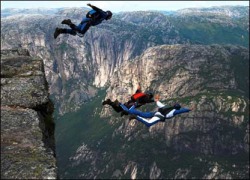BASE Jumping
For those people who believe that jumping out of an aircraft at 14,000 ft and free-falling at more than 100 mph isn't extreme enough, there is BASE jumping. BASE jumping involves jumping off of cliffs or various man-made objects at a low altitude, with only a few seconds to deploy a parachute. There is virtually no time to deal with problems or malfunctions, making this sport very risky and illegal in several places.
BASE jumping is an acronym for the four different objects one can jump from. The first is Buildings, which is very difficult because most buildings and monuments have security, locked doors, and other obstacles that prevent someone from getting to the top and leaping off. The next is Antennas, which are uninhabited towers such as an aerial mast. These are popular jumping points because they are extremely tall, easy to climb, and have less security. Antennas are often found in out-of-the-way places. The third object is Spans or bridges, which have to cross over large canyons or gorges to be acceptable for BASE jumping. The last object one can jump off of is Earth, which includes a cliff or other natural formations such as canyons, fjords, and gorges.
BASE jumping is similar to skydiving, but there are several differences. The terminal velocity and jump height give a BASE jumper less time and space to deploy a parachute. Therefore, BASE jumpers use specially adapted ram-air parachutes, which can open quickly at lower descent speeds. Ram-air parachutes are rectangular in shape to give the jumper greater control over direction and speed once deployed. A parachute made especially for BASE jumping can cost anywhere from $1,200 to $1,500. Lastly, even hardcore extreme sports fanatics consider BASE jumping to be a very dangerous sport, due to the inherent risk of death or injury.



